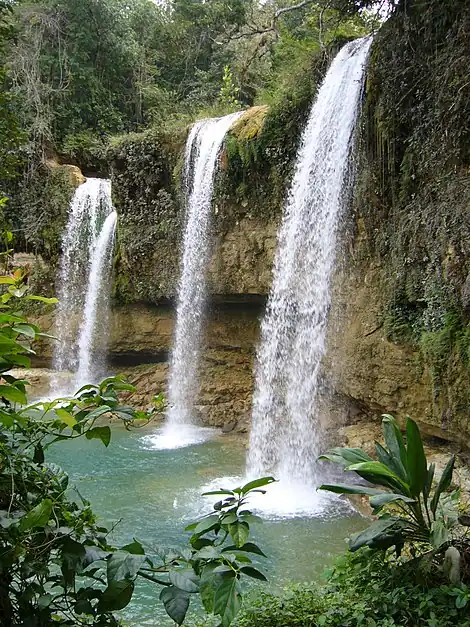Bayaguana
Bayaguana is a municipality (municipio) of the Monte Plata province in the Dominican Republic.[3]
Bayaguana | |
|---|---|
 Church | |
 Seal | |
 Bayaguana | |
| Coordinates: 18°45′N 69°38′W | |
| Country | |
| Province | Monte Plata |
| Founded | 1606 |
| Area | |
| • Total | 877.99 km2 (338.99 sq mi) |
| Elevation | 61 m (200 ft) |
| Population (2012) | |
| • Total | 34,786 |
| • Density | 40/km2 (100/sq mi) |
| • Urban | 19,001 |
| • Rural | 15,785 |
| Municipal Districts | 0 |
| Distance to – Monte Plata | 21 km |
As of the Dominican Republic's 2002 census, the municipality had a total population of 34,786 inhabitants, of which 19,001 resided in urban areas and 15,785 in rural areas.
History
Bayaguana was founded in 1606, when Spain resettled colonists from the northern and western part of Hispaniola closer to Santo Domingo, under the government eviction programme known as the devastations of Osorio. Spanish colonists from La Yaguana and Bayajá (present-day Léogâne and Fort-Liberté, Haiti) were resettled in the town. The economy is centered on cattle-ranching and pineapple and rice farming.
Economy

It operates the agricultural line, as well as part of its land is sown with sugar cane, pineapple and natural pastures for food for the cattle that it has in abundance.
A site of great tourist attraction is located near the town of Bayaguana. It is the Salto de Comate, in the river of the same name, where hundreds of people flock every day to enjoy a bath in its cold waters. There are also the spas of Comatillo, in Comatillo, Salto Alto, in Sierra de Agua, among others. In turn, part of one of the main national parks, Los Haitises National Park, is located in Bayaguana.
Climate
| Climate data for Bayaguana (1971–2000) | |||||||||||||
|---|---|---|---|---|---|---|---|---|---|---|---|---|---|
| Month | Jan | Feb | Mar | Apr | May | Jun | Jul | Aug | Sep | Oct | Nov | Dec | Year |
| Record high °C (°F) | 33.5 (92.3) |
34.0 (93.2) |
36.5 (97.7) |
36.5 (97.7) |
36.0 (96.8) |
36.0 (96.8) |
35.6 (96.1) |
39.5 (103.1) |
35.6 (96.1) |
35.5 (95.9) |
35.0 (95.0) |
35.5 (95.9) |
39.5 (103.1) |
| Average high °C (°F) | 27.2 (81.0) |
27.5 (81.5) |
28.2 (82.8) |
28.7 (83.7) |
28.9 (84.0) |
29.4 (84.9) |
29.6 (85.3) |
29.6 (85.3) |
29.5 (85.1) |
29.2 (84.6) |
28.4 (83.1) |
27.3 (81.1) |
28.6 (83.5) |
| Daily mean °C (°F) | 24.1 (75.4) |
24.3 (75.7) |
24.9 (76.8) |
25.6 (78.1) |
26.3 (79.3) |
27.0 (80.6) |
27.1 (80.8) |
27.0 (80.6) |
27.0 (80.6) |
26.6 (79.9) |
25.8 (78.4) |
24.5 (76.1) |
25.9 (78.5) |
| Average low °C (°F) | 18.7 (65.7) |
18.7 (65.7) |
19.1 (66.4) |
20.1 (68.2) |
21.3 (70.3) |
22.1 (71.8) |
22.0 (71.6) |
22.0 (71.6) |
21.9 (71.4) |
21.5 (70.7) |
20.8 (69.4) |
19.4 (66.9) |
20.6 (69.1) |
| Record low °C (°F) | 14.0 (57.2) |
12.5 (54.5) |
13.2 (55.8) |
14.0 (57.2) |
14.6 (58.3) |
19.0 (66.2) |
19.0 (66.2) |
18.0 (64.4) |
18.8 (65.8) |
17.7 (63.9) |
16.1 (61.0) |
13.4 (56.1) |
12.5 (54.5) |
| Average rainfall mm (inches) | 58.5 (2.30) |
71.3 (2.81) |
82.5 (3.25) |
134.4 (5.29) |
253.5 (9.98) |
196.4 (7.73) |
208.8 (8.22) |
267.8 (10.54) |
241.7 (9.52) |
194.9 (7.67) |
114.0 (4.49) |
59.4 (2.34) |
1,883.2 (74.14) |
| Average rainy days (≥ 1.0 mm) | 7.3 | 7.2 | 7.0 | 10.1 | 13.9 | 13.1 | 14.4 | 16.4 | 16.2 | 14.7 | 10.9 | 8.2 | 139.4 |
| Average relative humidity (%) | 77.7 | 74.9 | 73.1 | 75.1 | 79.2 | 79.1 | 79.3 | 81.3 | 82.4 | 82.7 | 81.2 | 79.2 | 78.8 |
| Source: ONAMET[4] | |||||||||||||
| Climate data for Bayaguana (1961–1990) | |||||||||||||
|---|---|---|---|---|---|---|---|---|---|---|---|---|---|
| Month | Jan | Feb | Mar | Apr | May | Jun | Jul | Aug | Sep | Oct | Nov | Dec | Year |
| Record high °C (°F) | 36.0 (96.8) |
35.5 (95.9) |
36.5 (97.7) |
36.5 (97.7) |
37.0 (98.6) |
37.5 (99.5) |
37.5 (99.5) |
39.5 (103.1) |
37.5 (99.5) |
37.0 (98.6) |
36.0 (96.8) |
37.8 (100.0) |
39.5 (103.1) |
| Average high °C (°F) | 30.1 (86.2) |
30.6 (87.1) |
31.5 (88.7) |
31.8 (89.2) |
32.2 (90.0) |
32.6 (90.7) |
32.7 (90.9) |
32.7 (90.9) |
32.7 (90.9) |
32.4 (90.3) |
31.5 (88.7) |
30.1 (86.2) |
31.7 (89.1) |
| Daily mean °C (°F) | 24.7 (76.5) |
24.9 (76.8) |
25.6 (78.1) |
26.2 (79.2) |
27.0 (80.6) |
27.5 (81.5) |
27.6 (81.7) |
27.6 (81.7) |
27.6 (81.7) |
27.2 (81.0) |
26.4 (79.5) |
25.0 (77.0) |
26.4 (79.5) |
| Average low °C (°F) | 19.3 (66.7) |
19.3 (66.7) |
19.7 (67.5) |
20.6 (69.1) |
21.8 (71.2) |
22.5 (72.5) |
22.6 (72.7) |
22.5 (72.5) |
22.5 (72.5) |
22.1 (71.8) |
21.3 (70.3) |
19.9 (67.8) |
21.2 (70.2) |
| Record low °C (°F) | 14.0 (57.2) |
12.5 (54.5) |
13.2 (55.8) |
14.0 (57.2) |
14.6 (58.3) |
19.0 (66.2) |
18.0 (64.4) |
18.0 (64.4) |
18.8 (65.8) |
17.7 (63.9) |
16.1 (61.0) |
13.4 (56.1) |
12.5 (54.5) |
| Average rainfall mm (inches) | 45.4 (1.79) |
61.1 (2.41) |
78.8 (3.10) |
126.8 (4.99) |
232.0 (9.13) |
229.6 (9.04) |
227.3 (8.95) |
281.4 (11.08) |
217.6 (8.57) |
200.8 (7.91) |
117.0 (4.61) |
58.3 (2.30) |
1,876.1 (73.86) |
| Average rainy days (≥ 1.0 mm) | 6.1 | 6.0 | 6.3 | 8.1 | 13.5 | 14.2 | 14.2 | 16.2 | 15.5 | 15.4 | 9.7 | 7.2 | 132.4 |
| Average relative humidity (%) | 77.5 | 74.6 | 73.2 | 74.9 | 78.8 | 79.3 | 79.4 | 81.3 | 82.3 | 82.8 | 81.1 | 79.2 | 78.7 |
| Source: NOAA[5] | |||||||||||||
References
- Superficies a nivel de municipios, Oficina Nacional de Estadistica Archived April 17, 2009, at the Wayback Machine
- De la Fuente, Santiago (1976). Geografía Dominicana (in Spanish). Santo Domingo, Dominican Republic: Editora Colegial Quisqueyana.
- "Listado de Codigos de Provincias, Municipio y Distritos Municipales, Actualizada a Junio 20 del 2006" (in Spanish). Oficina Nacional de Estadistica, Departamento de Cartografia, Division de Limites y Linderos. 20 June 2006. Archived from the original on 14 March 2007. Retrieved 12 August 2011.
- "Datos climatológicos normales y extremos 71-2000 estaciones Sinópticas - tercer trimestre 2019" (in Spanish). Oficina Nacional de Meteorología. Retrieved 20 October 2020.
- "Bayaguana Climate Normals 1961-1990". National Oceanic and Atmospheric Administration. Retrieved September 21, 2016.